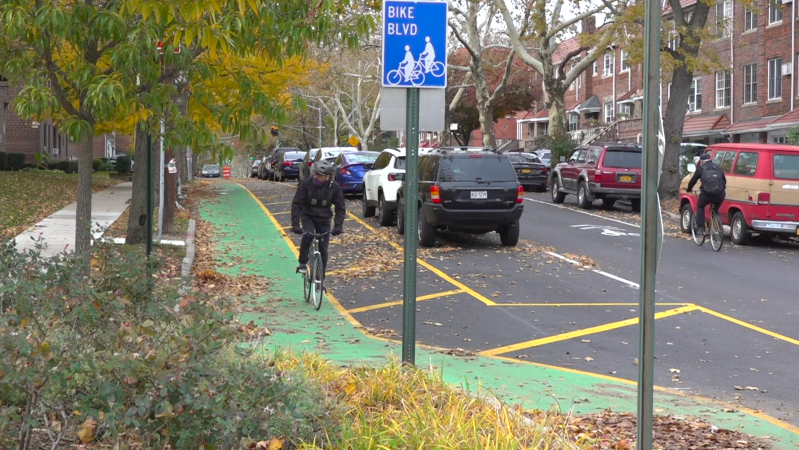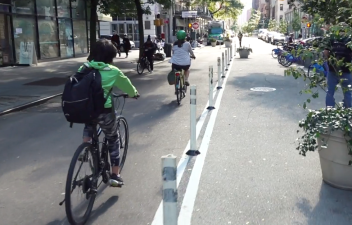SEE IT! Streetfilms Takes You to the ‘Bike Boulevard’


The city’s new “bike boulevards” are a success.
Mentioned as an aside in Mayor de Blasio’s State of the City address earlier this year, the Department of Transportation’s redesigned roadways on 39th Avenue in Queens and 20th Street in Brooklyn have reduced thru-car traffic, promoted cycling and reduced the potential for crashes due to lower speeds.
Over the weekend, Streetfilms auteur Clarence Eckerson Jr. put the punctuation mark on the two-month installation of the 39th Avenue redesign with a film that demonstrates that the DOT largely attained its goals. See here:
Before the construction of the bike boulevard, the residential roadway in Sunnyside was a dangerous strip for all road users thanks to speeding drivers using the roadway as a shortcut between Long Island City and Woodside. But now, thanks to a traffic diverter at 50th Street and a new car-free plaza replacing the westernmost block on the stretch, drivers can’t race through the neighborhood.

“One of the most notable differences is the slowdown in traffic and decrease in speeding,” said area resident Joe LaBello, echoing the praise of many cyclists and residents of the area.
How much safer are those nine blocks? Well, in the six years between 2014 and 2019, there were 110 reported car crashes on that strip, injuring 12 cyclists, 10 pedestrians and 18 motorists. That’s a rate of one one or two crashes every month.
In the two months since the bike boulevard was being built and completed, there have been no reported crashes at all on the same stretch. No one has been injured, according to city records. (It’s too early to tell about the bike boulevard on 20th Street in Park Slope; it’s not truly finished yet, but residents in the area say that changing 20th Street to one-way has reduced speeds, encouraged cycling and lowered car volumes.)
“Our 39th Avenue Bike Boulevard improves safety for pedestrians and cyclists, while providing Sunnyside residents with better public space and safer cycling connections to enjoy right outside their doorsteps,” said DOT spokesman Vin Barone.
Of course, the Department of Transportation didn’t just come up with the idea of a “bike boulevard” all on its own. Other cities have been doing it for years (Tuscon is a leader, even). And then, during the pandemic, the civic group City Rise promoted the notion in a video presentation that presciently hyped bike boulevards as a way of avoiding the post-pandemic carmageddon that New York is currently experiencing.
And StreetopiaUWS (full disclosure: that organization shares a parent company with Streetsblog) showed off a stripped-down design on the short-lived West End Avenue open street last November, as reported then by Streetsblog.

